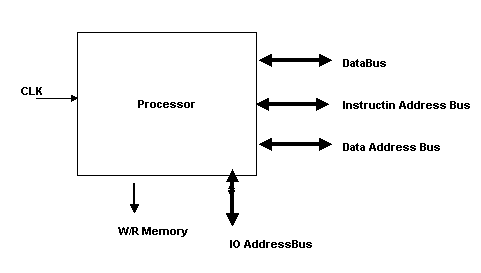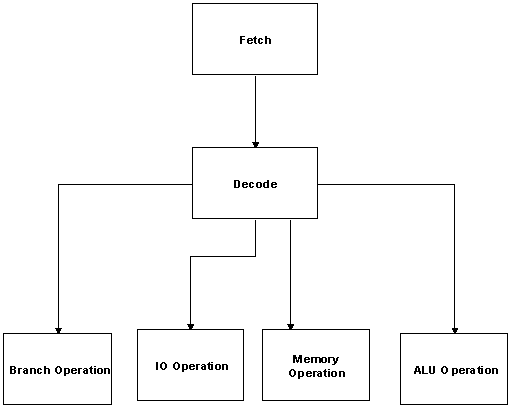The VHDL program:
---------------------------------------------------------------------------------------------------------------------------
Entity UProcessor is
Port ( clk :In Bit;
--InstructionBus :Inout Bit_Vector( 0 to 15 ) ;
DataBus :Inout Bit_Vector( 0 to 15 ) ;
InstructionAddressBus :out Bit_Vector( 0 to 15 ) ;
DataAddressBus :out Bit_Vector( 0 to 15 ) ;
IOAddressBus :out Bit_Vector( 0 to 3 ) ;
WriteMem :out Bit
);
end UProcessor;
---------------------------------------------------------------------------
Architecture UProcessorBehavior of UProcessor IS
--logical & arithmetic opcodes
constant OP_ADD : bit_vector(0 to 3) := "0000";constant
OP_ADDC: bit_vector(0 to 3) := "0001";
constant OP_SUB : bit_vector(0 to 3) := "0010";constant
OP_SUBB: bit_vector(0 to 3) := "0011";
constant OP_MUL : bit_vector(0 to 3) := "0100";constant
OP_DIV : bit_vector(0 to 3) := "0101";
constant OP_XOR : bit_vector(0 to 3) := "0110";constant
OP_OR : bit_vector(0 to 3) := "0111";
constant OP_AND : bit_vector(0 to 3) := "1000";constant
OP_SHL : bit_vector(0 to 3) := "1001";
constant OP_SHR : bit_vector(0 to 3) := "1010";constant
OP_ROL : bit_vector(0 to 3) := "1011";
constant OP_ROR : bit_vector(0 to 3) := "1100";constant
OP_NOT : bit_vector(0 to 3) := "1101";
constant OP_MOV : bit_vector(0 to 3) := "1110";constant
OP_NOP : bit_vector(0 to 3) := "1111";
--Registers
Signal A : Bit_vector(15 downto 0);Signal B : Bit_vector(15
downto 0);
Signal C : Bit_vector(15 downto 0);Signal D : Bit_vector(15
downto 0);
Signal E : Bit_vector(15 downto 0);Signal F : Bit_vector(15
downto 0);
Signal G : Bit_vector(15 downto 0);Signal H : Bit_vector(15
downto 0);
Signal I : Bit_vector(15 downto 0);Signal J : Bit_vector(15
downto 0);
Signal K : Bit_vector(15 downto 0);Signal L : Bit_vector(15
downto 0);
Signal M : Bit_vector(15 downto 0);Signal IOR : Bit_vector(3
downto 0);
Signal DS : Bit_vector(3 downto 0);Signal CS: Bit_vector(3
downto 0);
Signal PreIR : Bit_Vector(0 to 15) ;
Signal PC : Bit_Vector(0 to 11) ;
--This Register where the fitched data is stored
Signal DataReg : Bit_Vector(0 to 15);
--This flag determines which memroy to access ( data or
Instruction)
--1 Memory Operation
--0 ALU Operation
Signal OpsType : Bit;
--1 Load from memory to register
--0 Store from register to memory
Signal MemOpCode : Bit;
--Address of the destination or source register
Signal MemOperand : Bit_vector(0 to 1);
--ALU Opcode
Signal ALUOpcode :Bit_vector(0 to 3);
Signal ReadWriteMem :Bit;
Begin
---------------------------------------------------------------------------
Fetch : Process
--variable PC : Integer;
Begin
wait until clk = '1';
-- if the last decoded instruction was an ALU instruction
if( OpsType ='0' ) then -- I can not check it now because
the memory instruction is no executing now
PreIR <= DataBus;
--Program counter must be incremented here.!!!?
--ProgramCounter := PC + 1;
--InstructionAddressbus(3 to 13)<= ProgramCounter ;
--InstructionAddressbus(0 to 2)<= InstructionSegment
;
elsif ( ReadWriteMem ='1' ) then
DataReg <= DataBus;
end if;
End process Fetch;
----------------------------------------------------------------------------------------------
Decode: Process Begin
wait until clk = '1';
if PreIR(0) = '1' then
--I have a memory transfer Instruction
-- Can I load it here or before executing the instrution
--Load the Data Address bus with the address
DataAddressBus(4 to 15 ) <= PreIR(4 to 15);
DataAddressBus(0 to 3 ) <= DS;
OpsType <= '1'; --memory transfer Operation
--Can I set the here?
MemOpCode <= PreIR(1);
MemOperand <= PreIR(2 to 3 );
--Non Memory transfer Instruction
else
--Arithmetic and logical Instructions
case PreIR(1 to 2) is
when "00" | "01" =>
opsType <= '0';
case PreIR(4 to 7 ) is
when OP_ADD => ALUOpcode <= OP_ADD;
when OP_ADDC => ALUOpcode <= OP_ADDC;
when OP_SUB => ALUOpcode <= OP_SUB;
when OP_SUBB => ALUOpcode <= OP_SUBB;
when OP_MUL => ALUOpcode <= OP_MUL;
when OP_DIV => ALUOpcode <= OP_DIV;
when OP_XOR => ALUOpcode <= OP_XOR;
when OP_OR => ALUOpcode <= OP_OR;
when OP_AND => ALUOpcode <= OP_AND;
when OP_SHL => ALUOpcode <= OP_SHL;
when OP_SHR => ALUOpcode <= OP_SHR;
when OP_ROL => ALUOpcode <= OP_ROL;
when OP_ROR => ALUOpcode <= OP_ROR;
when OP_NOT => ALUOpcode <= OP_NOT;
when OP_MOV => ALUOpcode <= OP_MOV;
when OP_NOP => ALUOpcode <= OP_NOP;
end case;
--Jump Instructions
when "10" => ALUOpcode(0 to 1) <= "10";
--IO Instructions
when "11" => ALUOpcode(0 to 1) <= "11";
end case;
end if;
end Process decode;
-----------------------------------------------------------------------------
ExecuteALU : Process ( clk, OpsType)
Begin
if( (clk ='1') and (OpsType = '0')) then
A <= B;
end if;
End Process ExecuteALU;
------------------------------------------------------------------------------
ExecuteMemory :Process ( clk , OpsType)
Begin
if( (clk ='1') and (OpsType = '1')) then
-- load instruction
if( MemOpCode = '0') then
WriteMem <='1';
ReadWriteMem <= '1';
case MemOperand is
when "00" => A <= DataReg;
when "01" => B <= DataReg;
when "10" => C <= DataReg;
when "11" => D <= DataReg;
end case;
--Store Instruction
else
WriteMem <= '0';
ReadWriteMem <= '0';
case MemOperand is
when "00" => Datareg <= A;
when "01" => DataReg <= B;
when "10" => DataReg <= C;
when "11" => DataReg <= D;
end case;
end if;
end if;
End Process ExecuteMemory;
end UprocessorBehavior;


